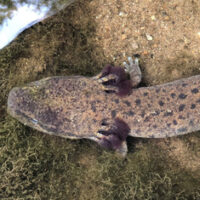 Purdue University - Extension - Forestry and Natural Resources
Purdue University - Extension - Forestry and Natural Resources
Got Nature? Blog
Illinois-Indiana Sea Grant (IISG) have four buoys now in place on the Great Lakes which inform scientists, weather forecasters, anglers, boaters, paddlers, surfers, swimmers and educational programs about current lake conditions. They collect data on wind speed, surface current, wave height, and water temperatures, providing valuable insights for scientists and the public.
- Michigan City Buoy – This buoy is located three miles offshore of Michigan City, Indiana. Purdue University’s Lyles School of Civil Engineering created the anchor used to keep the buoy in place. They also maintain and help deploy this buoy each year. The Michigan City Port Authority and the Lake Michigan Indiana Department of Natural Resources office played pivotal roles in helping deploy the anchor. The buoy itself was funded through a grant provided by Illinois-Indiana Sea Grant. A grant from the Indiana Department of Natural Resources Coastal Management Program allowed for the addition of the temperature chain.
- Chicago Buoy – This buoy, also called Chuoy, is based in the busy waters off Navy Pier, approximately a mile due east of the pier. This buoy is jointly owned and operated by Illinois-Indiana Sea Grant and the Lyles School of Civil Engineering at Purdue University.
For more information about Chuoy, check out this IISG article: New to Navy Pier waters, Chuoy the Buoy Proved a Valuable Forecasting Tool. - Wilmette Buoy – The Wilmette Buoy is situated approximately four miles off Wilmette, in Lake Michigan. The Sheridan Shore Yacht Club and the Coast Guard in Wilmette help deploy and store this buoy each year. Henry’s Sports and Bait shop in downtown Chicago helped deploy the anchor. The buoy was first deployed through a grant from the Great Lakes Observing System and the NOAA Coastal Storms Program.
- Waukegan Buoy – The Waukegan buoy is situated about a mile offshore from Waukegan Harbor in Lake Michigan. This buoy is owned and operated by the University of Illinois and the Illinois State Geological Survey. LimnoTech, Inc. and Illinois-Indiana Sea Grant play pivotal roles in helping deploy and support the buoy. The buoy was first deployed through a grant from NOAA. Continued funding support comes from the Illinois Department of Natural Resources Coastal Management Program.
For more information and photos view Purdue College of Agriculture News: Gearing Up for a Great Lake Day.
“The buoys act as a service to people who are active in Lake Michigan,” said Tomas Höök, director of Illinois-Indiana Sea Grant and professor of Forestry and Natural Resources at Purdue University. “A line runs from the surface of the buoy to the bottom of the lake, and sensors collect a variety of data. The buoy’s modem then communicates with a cell tower, providing data that anyone can access in real-time.”
“Near-record high water levels a few years ago were causing erosion along the shoreline, and there were even cases farther north in Lake Michigan of houses falling into the lake. But if you look back about 10 years, near-record low levels made the shoreline look like a mud flat,” Höök explained. “It’s important to understand because if infrastructure is built while the water is low, it’s highly likely the water level will rise back up and threaten that infrastructure.”
Subscribe to Illinois-Indiana Sea Grant YouTube Channel and view buoy videos along with fishing, water safety and other educational videos.
Illinois-Indiana Sea Grant is a partnership between NOAA, University of Illinois Extension, and Purdue University Forestry and Natural Resources, bringing science together with communities for solutions that work. Sea Grant is a network of 34 science, education and outreach programs located in every coastal and Great Lakes state, Lake Champlain, Puerto Rico and Guam.
Partners and Other Resources:
Lyles School of Civil Engineering, Purdue University
Henry’s Sports and Bait, Chicago, Illinois
Great Lakes Observing System
National Oceanic and Atmospheric Administration (NOAA) Coastal Storms Program
Illinois State Geological Survey
University of Illinois
Purdue University
Forestry and Natural Resources, Purdue University
LimnoTech
Illinois Department of Natural Resources Coastal Management Program
Indiana Department of Natural Resources Coastal Management Program
Lake Michigan Indiana Department of Natural Resources
Michigan City Port Authority
Center For Great Lakes Literacy (CGLL)
Eat Midwest Fish, Illinois-Indiana Sea Grant and North Central Regional Aquaculture Center
Informing the Development of the Great Lakes Region Decision Support System, The Education Store, Purdue Extension’s resource center
Fish Cleaning with Purdue Extension County Extension Director, Got Nature? Blog, Purdue Extension – Forestry and Natural Resources
Walleye Farmed Fish Fact Sheet: A Guide for Seafood Consumers, The Education Store
Using Buoy Data to Teach about Lake Michigan Conditions and Current Issues, Got Nature?
New Buoy Offers Real-Time Lake Michigan Data in Indiana, Got Nature?
Meet the buoys of summer who help Purdue and Illinois study Lake Michigan: BTN LiveBIG, BTN
National Data Buoy Center (noaa.gov), National Data Buoy Center
Diana Evans, Extension & Web Communications Specialist
Purdue University Department of Forestry and Natural Resources
Illinois-Indiana Sea Grant (IISG) has recently added to its YouTube Channel new water safety videos, which share what to watch for and how to stay out of those scary situations that can become dangerous very quickly.
Water Safety Basics: Water safety is more then just knowing how to swim. You need to what can cause hazards, what type of water bodies have hazards and how to avoid or survive those hazards.
Water Safety – What to Know Before You Go to the Beach: On average every year, 87 people die in the Great Lakes, half of them are in Lake Michigan. Ocean waves are very different from Great Lake waves.
Water Safety – Winter Beach Hazards: Water safety is so important during the winter. When covered in snow and ice, it’s difficult to tell where the beach ends and the lake begins. Shelf ice is beautiful but dangerous. There are many places where it cannot support a person’s weight, which may cause a fall into freezing water below, so you should never walk on shelf ice.
Water Safety – How to Escape Dangerous Currents: Of the five Great Lakes, Lake Michigan has the highest number of drownings and rescues each year. Lake Michigan is freshwater. This is so different from an ocean. It doesn’t have the salt, so it is lacking that buoyancy already. If waves get super high and rip currents start to form and that water gets volatile, it is going to be much harder to get out of the situation if you start struggling while you are swimming.
Water Safety – Southern Lake Michigan: Lake Michigan has also had more than 250 recorded cases of swimmers caught in rip currents since 2002, which is double the combined total of the other four Great Lakes. Make sure you check the forecast before you come and have a safety plan. In the ocean you can get hit by two waves in 15 seconds but in the Great Lakes you could get his with five waves in that same time period. Learn more about high frequency waves and how dangerous it can be.
Illinois-Indiana Sea Grant combines research, education, and outreach to empower southern Lake Michigan communities to secure a healthy environment and economy. The program is funded through National Oceanic and Atmospheric Administration (NOAA) via the National Sea Grant College Program, as well as the University of Illinois and Purdue University. IISG also works in partnerships with key organizations, institutions, and agencies in the region to reach more audiences and multiply opportunities for success. IISG brings together scientists, educators, policy makers, community decision makers, outreach specialists, business leaders, and the general public to work towards a healthy environment and economy.
Subscribe to the Illinois-Indiana Sea Grant (IISG) YouTube Channel.
More Resources:
Implementation Examples of Smart Growth Strategies in Indiana, The Education Store, Purdue Extension’s resource center
Conservation Through Community Leadership, The Education Store
Conservation Through Community Leadership, Sustainable Communities Extension Program (SCEP)
Conservation through Community Leadership, Purdue Extension You Tube Channel
Rainscaping Education Program, Purdue Extension
Rainscaping and Rain Gardens, Purdue Extension YouTube Channel
Tipping Point Planner, The Education Store
Tipping Point Planner, Purdue Agriculture YouTube Channel
Enhancing the Value of Public Spaces, The Education Store
Enhancing the Value of Public Spaces: Creating Healthy Communities, The Education Store
Enhancing the Value of Public Spaces Program, Purdue Extension YouTube Channel
One Water Approach to Water Resources Management, The Education Store
Community Development, Purdue Extension
Community Planning Playlist, Purdue Extension-Forestry & Natural Resources (FNR) YouTube Channel
Indiana Creek Watershed Project – Keys to Success, Partnerships and People, Subscribe to Purdue Extension-FNR YouTube Channel
Climate Change and Sustainable Development, The Education Store
Climate Change: Are you preparing for it?, The Education Store
Diana Evans, Extension & Web Communications Specialist
Purdue University Department of Forestry and Natural Resources
Wild Bulletin, Indiana Department of Natural Resources (DNR) Fish and Wildlife: Our latest Fishing Guide features women anglers, responsible fishing practices, a delicious French-style walleye recipe, and the regulations you need for having a successful day fishing in Indiana’s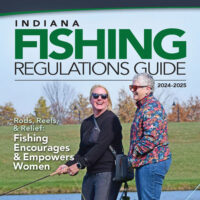 waters.
waters.
You can find the free guide online or pick up a hard copy at your local license retailer.
This guide provides a summary of Indiana fishing regulations. These regulations apply only to fish that originate from or are taken from Indiana’s public waters. Fish from public waters that migrate into or from private waters are still covered by these regulations. These regulations do not apply to fish in private waters that did not originate from public waters.
This guide is not intended to be a complete digest of regulations. If you need complete versions of Indiana rules and regulations for fishing, they can be found in Indiana Code or in Indiana Administrative Code Title 312.
To view this new guide, please visit Indiana Department of Natural Resources: Fishing Guide & Regulations.
Resources:
Hybrid Striped Bass Farmed Fish Fact Sheet, The Education Store
Largemouth Bass Farmed Fish Fact Sheet, The Education Store
Seafood Basics: A Toolkit for Understanding Seafood, Nutrition, Safety and Preparation, and Sourcing, The Education Store
Walleye Farmed Fish Fact Sheet, The Education Store
Rainbow Trout Farmed Fish Fact Sheet, The Education Store
A Guide to Small-Scale Fish Processing Using Local Kitchen Facilities, The Education Store
Aquaculture Family Coloring Book Development, The Education Store
Eat Midwest Fish, Illinois-Indiana Sea Grant online resource hub
Subscribe to Purdue Extension-Forestry & Natural Resources YouTube Channel, Wildlife Playlist
Indiana Department of Natural Resources
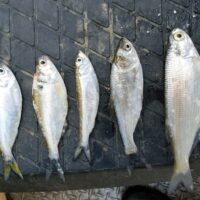
Fish from left to right: Threadfin Shad, Gizzard Shad, Skipjack Herring, Silver Carp (invasive carp), and Goldeye.
Wild Bulletin, Indiana Department of Natural Resources (DNR) Fish and Wildlife: Spring is the time anglers return to fishing on Indiana’s lakes and rivers. Often that includes catching and using live bait. Remember to dispose of all unused bait fish properly in the trash, as invasive carp could be lurking in your bait bucket. Improperly disposing of unused bait fish in a lake or stream could potentially allow invasive species, like silver carp, to spread in Indiana waters.
Invasive carp are a select group of cyprinid fishes (minnow family) that are native to Asia. The term “invasive carp,” formerly known as “Asian carp,” collectively refers to bighead carp, silver carp, grass carp, and black carp. Each of these species was intentionally introduced into the United States for different purposes; however, all are now considered invasive nationally and in Indiana. Invasive carp compete with native species and pose a threat to Indiana’s aquatic ecosystems.
Find out more about how you can help in the fight against invasive carp at DNR: Fish & Wildlife Resources.
Resources:
Asian Carp | Purdue University Report Invasive Species
Question: Aren’t There Concerns About Consuming Asian Carp As A Food Source In Indiana Streams?
Invasive Species, Playlist, Purdue Extension – FNR YouTube Channel
What are invasive species and why should I care?, Got Nature? Blog, Purdue Extension – Forestry and Natural Resources
Report Invasive Species, Purdue Invasive Species
Walleye Farmed Fish Fact Sheet, The Education Store, Purdue Extension’s resource center
Yellow Perch Farmed Fish Fact Sheet, The Education Store
A Guide to Small-Scale Fish Processing Using Local Kitchen Facilities, The Education Store
Eat Midwest Fish, Illinois-Indiana Sea Grant online resource hub
Indiana Department of Natural Resources
MyDNR, Indiana’s Outdoor Newsletter: All annual licenses and stamp privileges from last season expire on March 31. Purchase your 2024 license online, in person, or b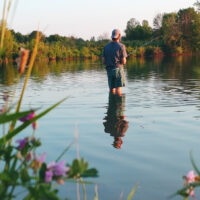 y mail, and check out our Licenses & Permits webpage for more information on license expiration dates and fees.
y mail, and check out our Licenses & Permits webpage for more information on license expiration dates and fees.
Once you have your new license, start planning for your spring fishing fun. The DNR starts stocking fish in early April, and you can take advantage of these opportunities to get an early start on your spring fishing adventures.
View fish stocking locations on the fish stocking webpage and Urban Fishing webpage. Mark your calendars for May 12, the first Free Fishing Day of the year.
To subscribe to the newsletter visit MyDNR Email Newsletter.
Resources:
Hybrid Striped Bass Farmed Fish Fact Sheet, The Education Store
Largemouth Bass Farmed Fish Fact Sheet, The Education Store
Seafood Basics: A Toolkit for Understanding Seafood, Nutrition, Safety and Preparation, and Sourcing, The Education Store
Walleye Farmed Fish Fact Sheet, The Education Store
Rainbow Trout Farmed Fish Fact Sheet, The Education Store
A Guide to Small-Scale Fish Processing Using Local Kitchen Facilities, The Education Store
Aquaculture Family Coloring Book Development, The Education Store
Eat Midwest Fish, Illinois-Indiana Sea Grant online resource hub
Ask an Expert: Wildlife Food Plots, video, Purdue Extension – FNR YouTube Channel
How to Build a Plastic Mesh Deer Exclusion Fence, The Education Store
Managing Your Woods for White-Tailed Deer, The Education Store
Handling Harvested Game: Episode 1, Field Dressing, video, Purdue Extension – FNR YouTube Channel
Deer Harvest Data Collection, Got Nature? Blog, Purdue Extension – FNR
Age Determination in White-tailed Deer, video, The Education Store
Subscribe to Purrdue Extension-Forestry & Natural Resources YouTube Channel, Wildlife Playlist
Indiana Department of Natural Resources
Illinois-Indiana Sea Grant Newsroom: The U.S. Department of State and the Fulbright Foreign Scholarship Board announced earlier this year that Kwamena Quagrainie of Purdue University received a Fulbright Specialist Program award. Through April and May of 2023, Dr. Quagrainie completed a project at Kwame Nkrumah University of Science and Technology, training faculty and graduate students about the economics of aquaculture. The project’s aim was to exchange knowledge and establish partnerships benefiting participants, institutions, and communities both in the U.S. and overseas through a variety of educational and training activities within the field of agriculture.
Dr. Quagrainie is one of over 400 U.S. citizens who share expertise with host institutions abroad through the Fulbright Specialist Program each year. Recipients of Fulbright Specialist awards are selected on the basis of academic and professional achievement, demonstrated leadership in their field, and their potential to foster long-term cooperations between institutions in the U.S. and abroad.
The Fulbright Program is the flagship international educational exchange program sponsored by the U.S. government and is designed to build lasting connections between the people of the United States and the people of other countries. The Fulbright Program is funded through an annual appropriation made by the U.S. Congress to the U.S. Department of State. Participating governments and host institutions, corporations, and foundations around the world also provide direct and indirect support to the Program, which operates in over 160 countries worldwide.
For full article and videos please visit Kwamena Quagrainie receives Fulbright Specialist award to Ghana – IISG
Resources
A Guide to Marketing for Small-Scale Aquaculture Producers, The Education Store
A Guide to Small-Scale Fish Processing Using Local Kitchen Facilities, The Education Store
Marine Shrimp Biofloc Systems: Basic Management Practices, The Education Store
Aquaculture Industry in Indiana Growing, Purdue Today
Walleye Farmed Fish Fact Sheet: A Guide for Seafood Consumers, The Education Store, Purdue Extension resource center
Sustainable Aquaculture: What does it mean to you?, The Education Store
The Benefits of Seafood Consumption The Education Store, Purdue Extension Resource Center
Walleye Farmed Fish Fact Sheet: A Guide for Seafood Consumers, The Education Store, Purdue Extension resource center
Pond and Wildlife Management website, Purdue Extension
Fish Cleaning with Purdue Extension County Extension Director, Got Nature? Blog, Purdue Extension – Forestry and Natural Resources
Aquatics & Fisheries, Playlist, Purdue Extension – Forestry and Natural Resources
Eat Midwest Fish, Illinois-Indiana Sea Grant online resource hub
Illinois-Indiana Sea Grant (IISG)
Wild Bulletin, Indiana Department of Natural Resources (DNR) Fish and Wildlife: The Division of Fish & Wildlife asks anglers to report sightings of the mudpuppy (Necturus maculosus) to help biologists track their populations across the state. A Species of Special Concern in Indiana, this salamander inhabits the state’s lakes and streams.
Mudpuppies, like fish, live their entire lives in water, but they are more secretive and difficult to locate. During winter, mudpuppies move into shallow water and are more frequently caught by anglers. They may also be viewed from shore using a flashlight at night, while they walk along the lake bottom. Mudpuppies are not dangerous or poisonous. They can be identified by the red, fluffy gills on the back of their head, but the gills tend to lay flat against their body when they are out of the water.
If you catch a mudpuppy while fishing, please photograph it, cut your fishing line, and release the mudpuppy back into the water. Report your observation to the DNR herpetologist at HerpSurveys@dnr.IN.gov and include a clear photograph of it, the date, and the location where it was found. The DNR appreciates your help tracking this unique salamander.
To learn more please visit DNR: Amphibians and Reptiles.
Resources:
Researchers Discover Young Hellbender in Blue River, Purdue Forestry and Natural Resources News & Stories
Help the Hellbender, North America’s Giant Salamander, The Education Store
Help the Hellbender, Purdue College of Agriculture
Question: Which salamander is this?, Got Nature? Blog, Purdue Extension – Forestry and Natural Resources
Is it a Hellbender or a Mudpuppy?, Got Nature? Blog
Amphibians: Frogs, Toads, and Salamanders, Purdue Nature of Teaching
A Moment in the Wild, Playlist, Purdue Extension – Forestry and Natural Resources
Help the Hellbender, Playlist & Website
The Nature of Teaching: Adaptations for Aquatic Amphibians, The Education Store, Purdue Extension resource center
Hellbenders Rock!, The Education Store
Indiana Department of Natural Resources
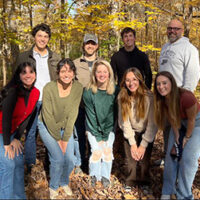 Dr. Rod Williams, extension wildlife specialist Nick Burgmeier and the Help the Hellbender team were honored for their collaboration with partners, outreach to the community and awareness education with the 2023 Indiana Friend of Conservation Award on January 9 in Indianapolis. The award, sponsored by Brownfield Ag News and presented by the Indiana Association of Soil and Water Conservation Districts (IASWCD) at its annual Conservation Awards Luncheon, recognizes individuals of entities who have made an outstanding contribution to soil and water conservation in Indiana. State level honorees are named in the corporate, individual and nonprofit/government categories.
Dr. Rod Williams, extension wildlife specialist Nick Burgmeier and the Help the Hellbender team were honored for their collaboration with partners, outreach to the community and awareness education with the 2023 Indiana Friend of Conservation Award on January 9 in Indianapolis. The award, sponsored by Brownfield Ag News and presented by the Indiana Association of Soil and Water Conservation Districts (IASWCD) at its annual Conservation Awards Luncheon, recognizes individuals of entities who have made an outstanding contribution to soil and water conservation in Indiana. State level honorees are named in the corporate, individual and nonprofit/government categories.
Burgmeier and Eliza Hudson, the Farmers Helping Hellbenders Project Coordinator for the Regional Conservation Partnership Program, accepted the award on the Help the Hellbender team’s behalf.
The team was nominated for the state level award in the nonprofit/government category by virtue of receiving the Washington County Soil & Water Conservation District’s Friend of Conservation Award in February.
The eastern hellbender (Cryptobranchus alleganiensis alleganiensis) is a large, fully aquatic salamander, nicknamed the snot otter, water dog, devil dog, Allegheny alligator and water eel among other things. Their decline statewide has been documented as far back as the early-to-mid 1900s as a result of habitat loss and poor water quality. Hellbenders play an important role in aquatic ecosystems and are indicators of clean water.
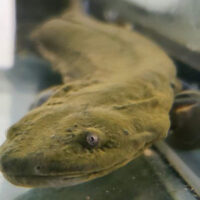
For much of the last 17 years, Williams and his team have been researching eastern hellbenders, spearheading regional conservation efforts and advancing hellbender captive propagation, or the rearing of this ancient animal in captivity and their eventual return to the wild. The partnership had a major breakthrough over the summer with the documentation of a young hellbender salamander in the Blue River while conducting routine surveys. This discovery is significant because over the past three to four decades, only adult hellbenders have been documented in the Blue River. The presence of a young salamander suggests that conservation efforts and rearing programs are accomplishing their goals for the recovery of this endangered species.
The Help the Hellbender lab is actively collaborating with the Indiana Department of Natural Resources, Indiana Division of Fish and Wildlife and The Nature Conservancy as well as several other partners across 13 states on a number of conservation projects and educational opportunities forteachers and children, farmers and more.
To see the full article please visit the FNR News & Stories page.
Resources:
Help the Hellbender website
Help the Hellbender Facebook page
Ask the Expert: Learn All About Hellbenders and Take a Tour, Subscribe Purdue Extension – Forestry & Natural Resources (FNR) YouTube Channel
Ask the Expert video: Help the Hellbender – Dr. Stephen Spear of The Wilds, Purdue Extension – FNR YouTube Channel
Ask the Expert video: Live with Mesker Park Zoo and Botanical Gardens – Hellbenders, Purdue Extension – FNR YouTube Channel
A Moment in the Wild video: Hellbender Hide, Purdue Extension – FNR YouTube Channel
A Moment in the Wild video: Release Moment of Hellbenders,
How Anglers and Paddlers Can Help the Hellbender video, Purdue Extension – FNR YouTube Channel
Eastern Hellbender ID Video, Purdue Extension – FNR YouTube Channel
Hellbenders Rock!, The Education Store, Purdue Extension’s resource center
Help the Hellbender, North America’s Giant Salamander, The Education Store
How Our Zoos Help Hellbenders, The Education Store
The Nature of Teaching: Adaptations for Aquatic Amphibians, The Education Store
Healthy Water, Happy Home – Lesson Plan, The Education Store
Purdue Expert: Hellbender Salamander, Purdue University News YouTube Channel
FNR Assists in First Natural Breeding of Eastern Hellbender in Captivity, Purdue FNR News & Stories
Helping the Hellbender: Mesker Park Zoo Begins Captive Breeding Efforts, Purdue Agriculture News
Wendy Mayer, FNR Communications Coordinator
Purdue University Department of Forestry and Natural Resources
Indiana Association of Soil and Water Conservation Districts (IASWCD)
Are you curious about eastern hellbender salamanders? Learn about their biology, ecology and the work that is being done in Indiana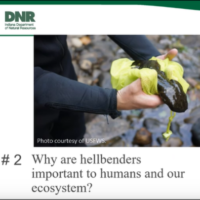 and beyond to restore the populations of this endangered species in a newly released webinar from the Indiana Department of Natural Resources.
and beyond to restore the populations of this endangered species in a newly released webinar from the Indiana Department of Natural Resources.
The “Conservation of the Hellbender: Experts Unite” webinar, which originally took place on Nov. 14, 2023, features a panel discussion between FNR Extension wildlife specialist Nick Burgmeier, Nate Engbrecht, Indiana state herpetologist, and Leigh Ramon, animal curator at Mesker Park Zoo and Botanic Gardens).
The webinar is now available on the Indiana Department of Natural Resources’ YouTube channel.
For much of the last 17 years, Dr. Rod Williams and his team have been researching eastern hellbenders, spearheading regional conservation efforts and advancing hellbender captive propagation, or the rearing of this ancient animal in captivity and their eventual return to the wild. Beginning January 2024, Dr. Jason Hoverman will act as lead investigator for the Help the Hellbender lab’s work at Purdue.
Purdue’s hellbender lab is actively collaborating with the Indiana Department of Natural Resources, Indiana Division of Fish and Wildlife and The Nature Conservancy as well as several other partners across 13 states on a number of conservation projects and educational opportunities forteachers and children, farmers and more.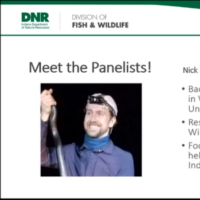
The “Farmers Helping Hellbenders” project, led by Williams and Purdue Extension wildlife specialist/Help the Hellbender project coordinator Nick Burgmeier, was selected in August 2022 to receive $2.7 million in funding through the RCCP Classic fund. The project aims to improve hellbender habitat in a four-county region in south central Indiana, the only remaining habitat for hellbenders in the state, by expanding the use of agricultural conservation practices that lead to decreased sedimentation in local rivers systems. Williams talks more about hellbenders and the project in this YouTube video.
The Indiana Hellbender Partnership is a collaboration between the Indiana DNR and Purdue University with funding support from the Indiana DNR Nongame Wildlife Fund, U.S. Fish & Wildlife Service, and partners in local governments, universities, non-governmental organizations, and zoos that are working to recover the state-endangered hellbender. Developed over 15 years, the Indiana Hellbender Partnership is the largest and most comprehensive group working to recover an imperiled amphibian in Indiana.
Resources:
Help the Hellbender website
Help the Hellbender Facebook page
Ask the Expert: Learn All About Hellbenders and Take a Tour, Subscribe Purdue Extension – Forestry & Natural Resources (FNR) YouTube Channel
Ask the Expert video: Help the Hellbender – Dr. Stephen Spear of The Wilds, Purdue Extension – FNR YouTube Channel
Ask the Expert video: Live with Mesker Park Zoo and Botanical Gardens – Hellbenders, Purdue Extension – FNR YouTube Channel
A Moment in the Wild video: Hellbender Hide, Purdue Extension – FNR YouTube Channel
A Moment in the Wild video: Release Moment of Hellbenders, Purdue Extension – FNR YouTube Channel
How Anglers and Paddlers Can Help the Hellbender video, Purdue Extension – FNR YouTube Channel
Eastern Hellbender ID Video, Purdue Extension – FNR YouTube Channel
Hellbenders Rock!, The Education Store, Purdue Extension’s resource center
Help the Hellbender, North America’s Giant Salamander, The Education Store
How Our Zoos Help Hellbenders, The Education Store
The Nature of Teaching: Adaptations for Aquatic Amphibians, The Education Store
Healthy Water, Happy Home – Lesson Plan, The Education Store
Wendy Mayer, FNR Communications Coordinator
Purdue University Department of Forestry and Natural Resources
Indiana Department of Natural Resources (IN DNR)
Bluegill, also called bream, brim, sunfish, or panfish, are freshwater finfish in the Centrarchidae family. The native range includes the St. Lawrence-Great Lakes and Mississippi River basins from New York to Minnesota south to the Gulf; and Atlantic and Gulf Slope drainages from Virginia to Florida and Texas to New Mexico. They are found in slow moving streams, lakes, ponds, and reservoirs. They have deep bodies; tall and flat sides; and bluish coloration on the gill covers, or operculum. A dark spot at the base of the dorsal fin, small mouth, and vertical bars on the sides distinguish them from similar species. Often breeding with other sunfish species, resulting offspring can be distinctly shaped and colored.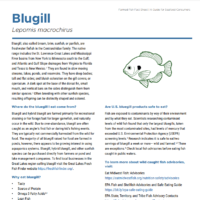
Where do the bluegill I eat come from?
Bluegill and hybrid bluegill are farmed primarily for recreational stocking or for forage/bait for larger gamefish, and naturally occur in the wild. Due to over-abundance, bluegill are often caught as an angler’s first fish or during kid’s fishing events. They are typically not commercially harvested from the wild for food. The majority of all bluegill raised for food are farmed in ponds, however, there appears to be growing interest in using aquaponics systems. Bluegill, hybrid bluegill, and other sunfish species can be purchased directly from farmers or pond and lake management companies. To find local businesses in the Great Lakes region selling bluegill visit the Great Lakes Fresh.
To receive the free download and recipe visit the Purdue Extension’s resource center: The Education Store – Bluegill Farmed Fish Fact Sheet.
Resources:
Hybrid Striped Bass Farmed Fish Fact Sheet, The Education Store
Freshwater Prawn Farmed Fish Fact Sheet, The Education Store
Ask An Expert: What is Aquaculture?, Purdue Extension FNR YouTube Channel
Walleye Farmed Fish Fact Sheet, The Education Store, Purdue Extension’s resource center
Pacific White Shrimp Farmed Fact Sheet, The Education Store
Yellow Perch Farmed Fish Fact Sheet, The Education Store
Tilapia Farmed Fish Fact Sheet, The Education Store
Rainbow Trout Farmed Fish Fact Sheet, The Education Store
American Paddlefish, The Education Store
A Guide to Small-Scale Fish Processing Using Local Kitchen Facilities, The Education Store
Aquaculture Family Coloring Book Development, The Education Store
Channel Catfish, The Education Store
Eat Midwest Fish, Illinois-Indiana Sea Grant online resource hub
Amy Shambach, Aquaculture Marketing Outreach Associate
Purdue Department of Forestry and Natural Resources/Illinois Indiana Sea Grant Program
Recent Posts
- Buoys Keep Eye on Great Lake Conditions
Posted: July 11, 2024 in Aquatic/Aquaculture Resources, Great Lakes, How To - IISG Adds New Water Safety Videos
Posted: May 8, 2024 in Aquaculture/Fish, Aquatic/Aquaculture Resources, Community Development, Great Lakes, Wildlife - 2024-25 Fishing Guide now available – Wild Bulletin
Posted: April 4, 2024 in Alert, Aquaculture/Fish, Aquatic/Aquaculture Resources, How To, Ponds, Wildlife - Look Out for Invasive Carp in Your Bait Bucket – Wild Bulletin
Posted: March 31, 2024 in Alert, Aquaculture/Fish, Aquatic/Aquaculture Resources, Invasive Animal Species, Wildlife - Renew Your Indiana Annual Fishing, Hunting, and Trapping License, MyDNR
Posted: March 28, 2024 in Aquaculture/Fish, Aquatic/Aquaculture Resources, How To, Wildlife - Kwamena Quagrainie Receives Fulbright Specialist Award to Ghana – IISG
Posted: March 27, 2024 in Aquaculture/Fish, Aquatic/Aquaculture Resources, Community Development - Report Your Mudpuppy Observations to Indiana DNR – Wild Bulletin
Posted: February 1, 2024 in Alert, Aquaculture/Fish, Aquatic/Aquaculture Resources, How To, Wildlife - Help the Hellbender Team Honored as Friends of Conservation
Posted: January 28, 2024 in Aquaculture/Fish, Aquatic/Aquaculture Resources, Wildlife - New Indiana DNR Webinar, Conservation of the Hellbender: Experts Unite
Posted: January 24, 2024 in Aquaculture/Fish, Aquatic/Aquaculture Resources, Webinar, Wildlife - Publication- Bluegill Farmed Fish Fact Sheet
Posted: December 15, 2023 in Aquaculture/Fish, Aquatic/Aquaculture Resources, Publication, Wildlife
Archives
Categories
- Alert
- Aquaculture/Fish
- Aquatic/Aquaculture Resources
- Ask the Expert
- Christmas Trees
- Community Development
- Disease
- Drought
- Forestry
- Forests and Street Trees
- Gardening
- Got Nature for Kids
- Great Lakes
- How To
- Invasive Animal Species
- Invasive Insects
- Invasive Plant Species
- Land Use
- Natural Resource Planning
- Nature of Teaching
- Plants
- Podcasts
- Ponds
- Publication
- Safety
- Spiders
- Timber Marketing
- Uncategorized
- Urban Forestry
- Webinar
- Wildlife
- Wood Products/Manufacturing
- Woodland Management Moment
- Woodlands

